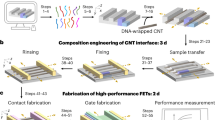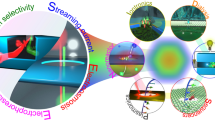Abstract
A nanoprocessor constructed from intrinsically nanometre-scale building blocks is an essential component for controlling memory, nanosensors and other functions proposed for nanosystems assembled from the bottom up1,2,3. Important steps towards this goal over the past fifteen years include the realization of simple logic gates with individually assembled semiconductor nanowires and carbon nanotubes1,4,5,6,7,8, but with only 16 devices or fewer and a single function for each circuit. Recently, logic circuits also have been demonstrated that use two or three elements of a one-dimensional memristor array9, although such passive devices without gain are difficult to cascade. These circuits fall short of the requirements for a scalable, multifunctional nanoprocessor10,11 owing to challenges in materials, assembly and architecture on the nanoscale. Here we describe the design, fabrication and use of programmable and scalable logic tiles for nanoprocessors that surmount these hurdles. The tiles were built from programmable, non-volatile nanowire transistor arrays. Ge/Si core/shell nanowires12 coupled to designed dielectric shells yielded single-nanowire, non-volatile field-effect transistors (FETs) with uniform, programmable threshold voltages and the capability to drive cascaded elements. We developed an architecture to integrate the programmable nanowire FETs and define a logic tile consisting of two interconnected arrays with 496 functional configurable FET nodes in an area of ∼960 μm2. The logic tile was programmed and operated first as a full adder with a maximal voltage gain of ten and input–output voltage matching. Then we showed that the same logic tile can be reprogrammed and used to demonstrate full-subtractor, multiplexer, demultiplexer and clocked D-latch functions. These results represent a significant advance in the complexity and functionality of nanoelectronic circuits built from the bottom up with a tiled architecture that could be cascaded to realize fully integrated nanoprocessors with computing, memory and addressing capabilities.
This is a preview of subscription content, access via your institution
Access options
Subscribe to this journal
Receive 51 print issues and online access
$199.00 per year
only $3.90 per issue
Buy this article
- Purchase on Springer Link
- Instant access to full article PDF
Prices may be subject to local taxes which are calculated during checkout




Similar content being viewed by others
Change history
11 February 2011
Figure 3d in the PDF was corrected on 11 February 2011
References
Lu, W. & Lieber, C. M. Nanoelectronics from the bottom up. Nature Mater. 6, 841–850 (2007)
Lu, W., Xie, P. & Lieber, C. M. Nanowire transistor performance limits and applications. IEEE Trans. Electron. Dev. 55, 2859–2876 (2008)
Das, S. et al. Designs for ultra-tiny, special-purpose nanoelectronic circuits. IEEE Trans. Circuits Syst. Regul. Pap. 54, 2528–2540 (2007)
Cui, Y. & Lieber, C. M. Functional nanoscale electronic devices assembled using silicon nanowire building blocks. Science 291, 851–853 (2001)
Huang, Y. et al. Logic gates and computation from assembled nanowire building blocks. Science 294, 1313–1317 (2001)
Zhong, Z. H., Wang, D. L., Cui, Y., Bockrath, M. W. & Lieber, C. M. Nanowire crossbar arrays as address decoders for integrated nanosystems. Science 302, 1377–1379 (2003)
Bachtold, A., Hadley, P., Nakanishi, T. & Dekker, C. Logic circuits with carbon nanotube transistors. Science 294, 1317–1320 (2001)
Javey, A. et al. High-κ dielectrics for advanced carbon-nanotube transistors and logic gates. Nature Mater. 1, 241–246 (2002)
Borghetti, J. et al. ‘Memristive’ switches enable ‘stateful’ logic operations via material implication. Nature 464, 873–876 (2010)
DeHon, A. Array-based architecture for FET-based, nanoscale electronics. IEEE Trans. Nanotechnol. 2, 23–32 (2003)
Das, S., Rose, G. S., Ziegler, M. M., Picconatto, C. A. & Ellenbogen, J. C. Architectures and simulations for nanoprocessor systems integrated on the molecular scale. Lect. Notes Phys. 680, 479–513 (2005)
Xiang, J. et al. Ge/Si nanowire heterostructures as high-performance field-effect transistors. Nature 441, 489–493 (2006)
Liu, J., Wang, Q., Long, S. B., Zhang, M. H. & Liu, M. A metal/Al2O3/ZrO2/SiO2/Si (MAZOS) structure for high-performance non-volatile memory application. Semicond. Sci. Technol. 25, 055013 (2010)
Sze, S. M. Physics of Semiconductor Devices 438–445 (Wiley, 1981)
Javey, A., Nam, S., Friedman, R. S., Yan, H. & Lieber, C. M. Layer-by-layer assembly of nanowires for three-dimensional, multifunctional electronics. Nano Lett. 7, 773–777 (2007)
Snider, G., Kuekes, P. & Williams, R. S. CMOS-like logic in defective, nanoscale crossbars. Nanotechnology 15, 881–891 (2004)
Whang, D., Jin, S., Wu, Y. & Lieber, C. M. Large-scale hierarchical organization of nanowire arrays for integrated nanosystems. Nano Lett. 3, 1255–1259 (2003)
Sakamoto, W. et al. in Proc. Electronic Devices Meeting 2009, 10.1109/IEDM.2009.5424211 (IEEE, 2009)
Sedra, A. S. & Smith, K. C. Microelectronics Circuits 1014–1021 (Oxford Univ. Press, 2004)
Xia, Q. F. et al. Memristor-CMOS hybrid integrated circuits for reconfigurable logic. Nano Lett. 9, 3640–3645 (2009)
Nam, S., Jiang, X. C., Xiong, Q. H., Ham, D. & Lieber, C. M. Vertically integrated, three-dimensional nanowire complementary metal-oxide-semiconductor circuits. Proc. Natl Acad. Sci. USA 16, 21035–21038 (2009)
Acknowledgements
We thank D. Bell and N. Antoniou for transmission electron microscopy sample preparation and imaging, Q. Qing for assistance with electrical measurements and J. L. Huang, X. Duan and X. Jiang for helpful discussions. C.M.L. acknowledges support from a National Security Science and Engineering Faculty Fellow award and a contract from the MITRE Corporation. S.D., J.F.K. and J.C.E. acknowledge support by the US government’s Nano-Enabled Technology Initiative and the MITRE Innovation Program.
Author information
Authors and Affiliations
Contributions
C.M.L., J.C.E., S.D., H.Y., H.S.C. and S.N. designed the experiments. H.Y., H.S.C., S.N., Y.H. and J.F.K. performed the experiments. S.D. performed simulations. H.Y., H.S.C., S.N., S.D., J.F.K., J.C.E. and C.M.L. analysed the data and wrote the paper. All authors discussed the results and commented on the manuscript.
Corresponding authors
Ethics declarations
Competing interests
The authors declare no competing financial interests.
Supplementary information
Supplementary Information
The file contains Supplementary Methods, Supplementary Figures 1-6 and additional references. (PDF 598 kb)
Rights and permissions
About this article
Cite this article
Yan, H., Choe, H., Nam, S. et al. Programmable nanowire circuits for nanoprocessors. Nature 470, 240–244 (2011). https://doi.org/10.1038/nature09749
Received:
Accepted:
Published:
Issue Date:
DOI: https://doi.org/10.1038/nature09749
This article is cited by
-
Ferroelectric gating of two-dimensional semiconductors for the integration of steep-slope logic and neuromorphic devices
Nature Electronics (2023)
-
Tunneling between parallel one-dimensional Wigner crystals
Scientific Reports (2022)
-
Study and Analysis of Advanced 3D Multi-Gate Junctionless Transistors
Silicon (2022)
-
Propagation of Short Pulses in Dispersion-Engineered Silicon Nanowires: Impact of Chirp Parameter
Silicon (2022)
-
ITO Nanoparticle Chemiresistive Sensor for Detecting Liquid Chemicals Diluted in Brine
Transactions on Electrical and Electronic Materials (2022)
Comments
By submitting a comment you agree to abide by our Terms and Community Guidelines. If you find something abusive or that does not comply with our terms or guidelines please flag it as inappropriate.



